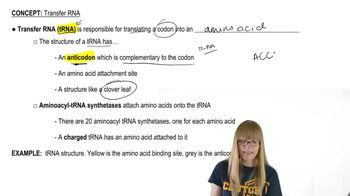Table of contents
- 1. Introduction to Genetics51m
- 2. Mendel's Laws of Inheritance3h 37m
- 3. Extensions to Mendelian Inheritance2h 41m
- 4. Genetic Mapping and Linkage2h 28m
- 5. Genetics of Bacteria and Viruses1h 21m
- 6. Chromosomal Variation1h 48m
- 7. DNA and Chromosome Structure56m
- 8. DNA Replication1h 10m
- 9. Mitosis and Meiosis1h 34m
- 10. Transcription1h 0m
- 11. Translation58m
- 12. Gene Regulation in Prokaryotes1h 19m
- 13. Gene Regulation in Eukaryotes44m
- 14. Genetic Control of Development44m
- 15. Genomes and Genomics1h 50m
- 16. Transposable Elements47m
- 17. Mutation, Repair, and Recombination1h 6m
- 18. Molecular Genetic Tools19m
- 19. Cancer Genetics29m
- 20. Quantitative Genetics1h 26m
- 21. Population Genetics50m
- 22. Evolutionary Genetics29m
11. Translation
Translation
Problem 11
Textbook Question
When a codon in an mRNA with the sequence 5'-UAA-3' enters the A site of a ribosome, it is not recognized by a tRNA with a complementary anticodon. Why not? What recognizes it instead?
 Verified step by step guidance
Verified step by step guidance1
Understand that the sequence 5'-UAA-3' is a stop codon in mRNA.
Recall that stop codons are not recognized by tRNA molecules because they do not code for any amino acids.
Recognize that instead of tRNA, stop codons are recognized by release factors.
Release factors bind to the stop codon in the A site of the ribosome.
The binding of release factors leads to the termination of translation and release of the polypeptide chain.
 Verified video answer for a similar problem:
Verified video answer for a similar problem:This video solution was recommended by our tutors as helpful for the problem above
Video duration:
1mPlay a video:
Was this helpful?
Key Concepts
Here are the essential concepts you must grasp in order to answer the question correctly.
Codons and Anticodons
Codons are sequences of three nucleotides in mRNA that specify an amino acid or signal termination during protein synthesis. Each codon is matched by a complementary anticodon found on tRNA molecules, which carry specific amino acids. In the case of the UAA codon, it is a stop codon, meaning it does not have a corresponding tRNA anticodon, which typically pairs with codons that code for amino acids.
Recommended video:
Stop Codons
Stop codons are specific codons in mRNA that signal the termination of protein synthesis. The three stop codons—UAA, UAG, and UGA—do not code for any amino acids and are recognized by release factors instead of tRNA. When a ribosome encounters a stop codon in the A site, it triggers the release of the newly synthesized polypeptide chain from the ribosome.
Recommended video:
Guided course

Translation Termination
Release Factors
Release factors are proteins that recognize stop codons during translation. When a ribosome reaches a stop codon, such as UAA, a release factor binds to the A site, prompting the ribosome to release the completed polypeptide chain. This process is crucial for terminating protein synthesis and ensuring that proteins are properly released and folded for their functional roles.
Recommended video:
Guided course

F Factor and Hfr

 7:58m
7:58mWatch next
Master Translation initiation with a bite sized video explanation from Kylia Goodner
Start learning




